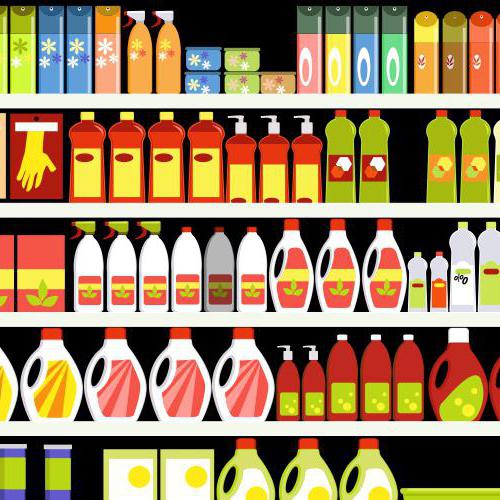The object of merchandising, commercial, marketing activities are goods and services. Their basic consumer properties are an important aspect of the study and improvement of production. Assessment problem product quality and services is closely related to determining the list of their properties and characteristics.

The concept of goods and services
A product is a complex multidimensional phenomenon; in its most general form, it is understood as a product produced in the course of human activities for sale or exchange. The emergence of goods is associated with the oldest type of communication between people who exchanged surpluses of different products and products for others. In a sense, we can say that the product is the source of civilization, because it is with the exchange that the improvement of production begins with the aim of increasing its quality and productivity. Marketing complements the understanding of the product with such an aspect as its ability to satisfy certain needs. The main feature of the product is the presence of special features. Any characteristic of consumer properties of a product invariably leads to a solution to the problem of assessing its quality.
A service is an intangible good that is produced by one person to meet the needs of another. There is much in common between a product and a service. Although there are significant differences: the service is intangible, inconsistent, inseparable from the subject of its provision and not preserved. And the main difference between the goods and services is the materiality of the first and the immateriality of the second. All these features significantly complicate the assessment of the quality of the service provided. If the consumer properties of products can be assessed by some objective physical criteria, then the service often causes significant difficulties in determining its characteristics and quality.

Product classification
Due to the huge variety of goods, it is impossible to create any single consistent and comprehensive classification. There are several reasons for highlighting varieties and groups of products.
First of all, the type of goods is determined by the trade criterion, in which case food and non-food products are distinguished. The first, in turn, are divided into many varieties. Flour and bakery, dairy, meat, fish, vegetables and fruits, confectionery, etc. Non-food products are divided into household, clothing and footwear, petroleum products, haberdashery, jewelry, electrical goods, etc. The type of goods is also highlighted by seasonality of their consumption: seasonal and non-seasonal.
Depending on the market, there are industrial and consumer goods. The former are for use in production, the latter are designed to meet the needs of end users. Industrial products include varieties such as raw materials, components, manufacturing and auxiliary materials, semi-finished products, real estate and capital property, as well as services. Consumer goods are usually classified, taking into account consumer behavior when they are purchased. Traditionally, such varieties are distinguished as consumer goods, long-term goods and products of careful choice, status goods, and passive goods.

Service Classification
Features of services and their significant differences from each other make it impossible to create reasonable classification of services. Traditionally, they are divided into areas in which they find themselves. So, it is customary to single out medical, passenger, sports, educational, informational, banking, legal, security, veterinary services, as well as services in the field of catering, beauty, repair, maintenance of cleanliness and real estate.
Specifications
Significant differences in goods and services lead to the fact that when evaluating and describing these or those characteristics apply. Goods are usually evaluated by quantitative and qualitative characteristics. In the theory of commodity science, a qualitative classification of products is carried out according to the following criteria:
- Assortment characteristics. Goods are usually assigned to certain groups in accordance with the purpose, functional features. For example, the “oil” group includes such different products as vegetable, butter or ghee.
- Cost characteristic. The price of a product consists of several components and is a criterion for its evaluation by consumers and entrepreneurs. This parameter allows you to assign the product to a specific cost group: economy segment, premium segment or luxury. The quantitative characteristics of the goods include dimensional and mass characteristics (length, volume, etc.), strength, packaging.
There are also consumer characteristics of the product, such as brand, image, fame, a set of criteria for evaluating a product by a buyer: reliability, durability, profitability, and others.
Assessing the consumer properties of services, it should be noted its unique characteristics, they include:
- Intangibility. It cannot be felt, only its results can be seen. At the same time, immateriality does not allow to establish ownership of the service; you can buy the result, but not the source.
- Nonconservation. Services cannot be accumulated or stored for future use, but their results can bring satisfaction to a need for a very long time, when they themselves are no longer provided.
- Variability of quality. The credibility or qualification of the service provider cannot be a guarantee of a good service, moreover, the assessment of its quality may vary between the parties to the contract. For example, a nail design may seem to the master to be of high quality, but the client does not like it.
- Inseparability from the service provider and the consumer. The provision of the service and its consumption most often coincide in time and cannot occur without the participation of both parties to the contract. So, a hairdresser cannot provide a service to an absent person.

Consumer Property Approaches
In commodity science, the concept of consumer properties is associated with the definition of reliability and quality of goods. By this, it is customary to understand the objective features of products that are manifested in the consumption process, allowing the buyer to satisfy various urgent needs. In the broadest sense, consumer properties are equated with utility, for which the buyer is ready to pay the agreed price. If the properties of the goods lend themselves well to evaluation and are prescribed in the corresponding nomenclature, then the characteristics of services are much more difficult to evaluate, and it can be difficult to develop uniform evaluation criteria. This function is performed by various standards that are developed by both government bodies and industry departments.
A special approach to the definition of consumer properties has developed in marketing. In this case, consumer properties are understood as the criteria by which the consumer of a product or service evaluates its quality. They can be not only objective, but also subjective, emotional, in this case, researchers talk about perceived quality. The perceived properties of the service are based on the needs of the buyer, on his personal preferences and stereotypes, on past experience in obtaining services, on external and internal communications.

Consumer properties of goods
The consumer evaluates the consumer properties of the products by the following parameters:
- Product Category The buyer, wanting to satisfy his need, at the first stage is determined with the general category of the product. For example, he needs a computer to work. He will choose between a stationary device, laptop or tablet, while he will have a long list of comparisons of these options. The type of product here plays a decisive role in the direction of further information search. Also, the choice of brand refers to the category category. So, when buying salt, the consumer rarely thinks about its manufacturer, and when you purchase a computer, the brand issue becomes much more significant.
- Price. An important parameter, which is associated not only with consumer resources, but also with its status, quality guarantee.
- Functional characteristics. The consumer always considers the purchase in relation to his needs: how fully and economically this product can satisfy this need. And the more complex the set of needs, the longer the service life of the product, and the higher the price, the larger the list of functional criteria.
- The pleasure of the purchase. Usually, the consumer does not realize that he is striving not just for the acquisition of goods, but for extracting emotional satisfaction from this process. Pleasure from the purchase and the result is a very important criterion. So, acquiring shoes in a beautiful, fashionable store, the girl experiences emotional satisfaction from the service and environment, and subsequently she will be pleased to tell others about where she purchased them. But the purchase of the same shoes on the market most often does not bring any pleasure, except for a pleasant price.
- Quality. The most difficult criterion that the consumer evaluates comprehensively, along with the previous parameters, focusing on objective indicators that are accepted in commodity science.

Service Properties
Describing the consumer properties of the service from the point of view of consumer choice, it should be said that in this case, in many ways, he applies the same criteria as in the evaluation of goods. This is prestige, and price, and category, and pleasure. However, the specific characteristics of the service make him think about special properties. These include the image of the service provider, past experience (of their own and / or reference groups), the possible consequences of receiving a high-quality or low-quality service.
In commodity science, it is customary to distinguish the following consumer properties of the services provided:
- Reliability. The service is assessed by the stability of the result, which is stable with respect to external interference and circumstances.
- Functionalism The service should satisfy the needs, preferably in relation to their whole complex.
- The reputation of the service provider. This parameter includes professional training of the company’s personnel, the availability of the necessary high-quality equipment, and compliance with sanitary requirements and safety standards.

Classification of consumer properties
Highlighting the types of consumer properties of goods and services, commodity researchers are based on the following factors:
- Ergonomic. It is important for a product or service to be comfortable and enjoyable to use. Packaging and equipment should take into account the physiology and physical parameters of the buyer. Also, the consumer should experience psychological comfort when using the product and when receiving the service.
- Functional. Goods and services must meet specific needs. The most common of these are physiological and social. Goods and services should be energetically and biologically valuable, they must also have inherent socially significant properties, which are evaluated through appearance, qualification, ability to comprehensively satisfy various needs.
- Aesthetic.The product or service should satisfy the buyer’s need for beauty.
- Reliability. It is important for the consumer that the product or service retains its functional purpose and ability to satisfy needs for a long time. Reliability as a product characteristic includes indicators such as durability, shelf life, maintainability, reliability.
The concept of the quality of goods and services
Assess the consumer properties of goods and services is necessary in order to determine their quality and relevance. Commodity research seeks to identify the optimal set of such properties. This concept is interpreted differently by specialists and consumers. For the former, the quality of the goods is a quantitative indicator of consumer properties that provide satisfaction of needs and are objective parameters. For the second, quality is often a subjective, even philosophical, category. Consumers often value quality through their expectations and perceptions.
Quality indicators are the following properties and characteristics of goods and services:
- Appearance. For a product, these are features of the packaging or the product itself. For a service, this is the type of staff and the location of its provision.
- Functional characteristics.
- Reliability and durability.
- Environmental friendliness.
In commodity science, it is customary to classify the quality indicators of goods and services according to such criteria as purpose, reliability, aesthetics, ergonomics, environmental friendliness and safety. To assess the quality of the service, additional indicators are introduced, such as the amount of equipment for the provision of the service, the features of the service process and its compliance with technological standards, the duration and reliability of the service results, informing the client about the features of the service delivery process.

Quality control
Since the quality of the goods is an objective indicator, it must be measured. Traditionally, quality assessment is made on the consumer properties of a product or service. There are several methods for determining this indicator:
- Expert. In this case, specially trained people are involved in the assessment process, who have audit skills and have special knowledge.
- Consumer. For this, various customer surveys are conducted, monitoring their behavior, interviewing.
- Organoleptic. In this case, the objective external characteristics of the product are evaluated: smell, appearance.
- Physico-chemical analysis. This method is applicable for assessing the quality of not all products, most often it is used for food research.
Quality assurance is an important part of the company's work, usually the criteria for its evaluation are prescribed in special documents.
Consumer Nomenclature
Consumer goods and services must meet many standards and requirements, quality control is carried out both by the enterprise itself and by special authorized bodies.
International Standard (ISO) defines quality as a comprehensive list of properties and characteristics of a product or service. Usually it is recorded in the range of consumer properties and is a list of properties of one product or group of similar products or services. To compile the nomenclature, it is necessary to study the product, draw up a detailed register of its properties and determine a list of the most important and measurable features that can be objectively evaluated. The nomenclature of consumer indicators of the quality of goods and services should correspond to the list of their most important properties.








